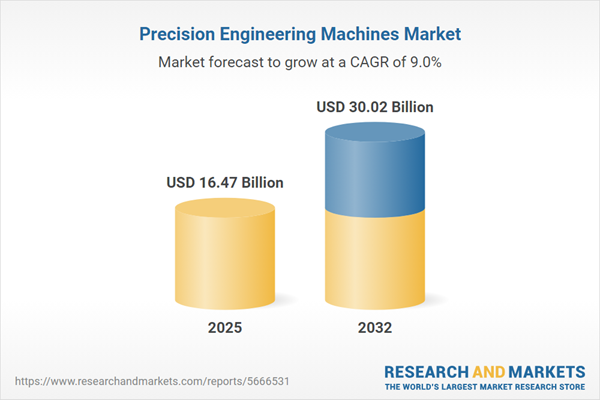Speak directly to the analyst to clarify any post sales queries you may have.
Precision engineering machines are increasingly vital for manufacturers seeking to enhance operational control, quality standards, and resilience. As market dynamics evolve, their adoption aligns with senior leadership’s focus on automation, compliance, and supply chain continuity.
Market Snapshot: Precision Engineering Machines Market
The global precision engineering machines market is experiencing robust, ongoing growth, reaching a value of USD 15.12 billion in 2024 and expected to climb to USD 16.47 billion by 2025. Market forecasts indicate expansion toward USD 30.02 billion by 2032, reflecting an 8.95% CAGR.
This expansion is propelled by the uptake of digitally connected manufacturing environments and strengthened process control for enhanced machining accuracy. Investment from established players and emerging entrants is rising as organizations adapt to shifting regulations and increasingly complex, globalized production ecosystems.Scope & Segmentation of the Precision Engineering Machines Market
- Product Types: CNC machines—horizontal and vertical—play a key role in automating workflows and consistently delivering quality in high-precision manufacturing. Electrical discharge machines (EDM), both sinker and wire types, facilitate ultra-accurate features crucial for regulatory traceability and stringent product validation.
- Grinding Machines: Centerless, cylindrical, and surface grinders deliver superior surface finishes and uniformity, addressing sectors that require compliance with demanding technical criteria.
- Laser Cutting Equipment: CO2 and fiber optic laser solutions support rapid prototyping, maximize material use, and underpin agile, adaptable operations to accelerate commercialization cycles.
- End Use Industries: Aerospace prioritizes high-precision components for traceability and performance, while automotive, electronics, and medical device manufacturing demand process validation and flexibility for regulatory compliance and safety.
- Sales Channels: Direct sales support specialized technical integration, while distributor networks enhance regional market reach. Online procurement aligns with just-in-time strategies, simplifying technology sourcing and deployment.
- Regional Coverage: Asia-Pacific leads growth due to industrial modernization and supportive policy initiatives in countries such as China, India, Japan, Australia, and key ASEAN members. North America, Europe, the Middle East, and Africa also drive market advancement, leveraging their established infrastructures and rising adoption of digital manufacturing.
- Key Companies: Leading providers—including DMG MORI AG, TRUMPF GmbH + Co. KG, Yamazaki Mazak Corporation, Haas Automation, Okuma Corporation, Amada Co., Makino Milling Machine Co., Doosan Machine Tools, Mitsubishi Heavy Industries, and Schuler AG—support manufacturers with advanced, innovative production solutions globally.
Key Takeaways for Senior Decision-Makers
- Advanced precision engineering machines improve oversight, enabling manufacturers to respond quickly to evolving customer needs and regulatory requirements through integrated monitoring and real-time quality controls.
- Incorporation of AI and IoT capabilities supports preventative maintenance and operational reliability, helping reduce unscheduled equipment downtime across automated production environments.
- Implementing energy-efficient systems and high-performance filtration aids manufacturers in meeting environmental objectives and shifting sustainability standards, while optimizing overall operational costs.
- Modular machine architectures offer adaptability, letting organizations scale output or modify production flows with minimal resource outlay and reduced disruption, increasing agility in volatile markets.
- Ongoing investment in modern manufacturing technology drives improved process workflows, bolsters competitiveness, and supports proactive risk management as companies distribute operations regionally and internationally.
Tariff Impact on Precision Engineering Machines
Emerging and implemented tariff policies in the United States are impacting sourcing and procurement approaches for manufacturers. These shifts are resulting in greater emphasis on nearshoring, strategic supplier engagement, and renegotiation of contracts to help sustain operations in an evolving global trade environment.
Methodology & Data Sources
This analysis draws on primary interviews with manufacturing executives and technical experts to accurately capture current industry priorities and challenges. Supplementary data from sector reports and technical publications further ensure actionable, relevant recommendations for executive-level decisions.
Why This Report Matters
- Equips leadership teams to align strategic product planning, market entry, and supplier relationships with the latest developments in technology and compliance.
- Supports procurement, risk mitigation, and flexible adaptation to shifting regulatory and manufacturing landscapes.
- Enables organizations to advance agility and maintain alignment with accelerated digital transformation across varied manufacturing contexts.
Conclusion & Next Steps
Precision engineering machines play a pivotal role in driving digital transformation and operational adaptation in manufacturing. These insights support leaders seeking to strengthen organizational resilience and navigate industry developments with confidence.
Additional Product Information:
- Purchase of this report includes 1 year online access with quarterly updates.
- This report can be updated on request. Please contact our Customer Experience team using the Ask a Question widget on our website.
Table of Contents
3. Executive Summary
4. Market Overview
7. Cumulative Impact of Artificial Intelligence 2025
Companies Mentioned
The companies profiled in this Precision Engineering Machines market report include:- DMG MORI AG
- TRUMPF GmbH + Co. KG
- Yamazaki Mazak Corporation
- Haas Automation, Inc.
- Okuma Corporation
- Amada Co., Ltd.
- Makino Milling Machine Co., Ltd.
- Doosan Machine Tools Co., Ltd.
- Mitsubishi Heavy Industries, Ltd.
- Schuler AG
Table Information
| Report Attribute | Details |
|---|---|
| No. of Pages | 198 |
| Published | November 2025 |
| Forecast Period | 2025 - 2032 |
| Estimated Market Value ( USD | $ 16.47 Billion |
| Forecasted Market Value ( USD | $ 30.02 Billion |
| Compound Annual Growth Rate | 8.9% |
| Regions Covered | Global |
| No. of Companies Mentioned | 11 |









